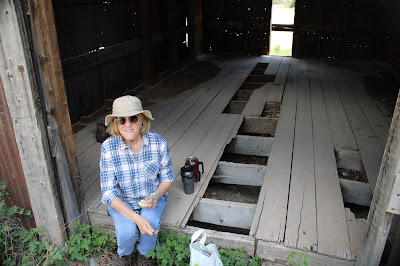Creede, Colorado was a wild and woolly mining town around the turn of the last century. Rich mineral deposits led to the development of large numbers of mines in and around Creede.
For a five million year period between thirty and twenty five million years ago the mountains surrounding Creede were continuously rocked by volcanic eruptions from seven different volcanoes. These volcanoes were quite vicious in their eruptions, similar to Mt. St. Helens but on a much larger scale. The volcanoes literally blew their tops and then collapsed to create a relatively flat area surrounded by the former walls of the volcano. This is called a Caldera.
The Creede Caldera was formed 27.5 million years ago and is the most recent of the seven Calderas in the area. It is 10 to 12 miles across and is one of the best preserved and most studied calderas in the world.
The resulting mineral deposits remained hidden until discovered by John Mackenzie, Nicholas Creede and others in the late 1800's. This led to the development of large numbers of mines in and around Creede.
Many of these mines are now located on a 17 mile circular drive known as the Bachelor Loop Historic Tour that starts and ends in Creede.
We took our Chevy Tracker on a trip to explore the area. Our trip took us by the overlook for Lake San Cristobal outside of Lake City, Colorado so we stopped to enjoy the view.
.
 |
| The D&RGW station still exists in Creede and is now a museum, but was closed due to the Covid19 so our chance to explore it will await a future time. |
 |
| A brochure you purchase at the visitors center describes the history of each of the stops along the way. |
.
 |
Interpretive signage tells the history of the area.
 |
 |
| I thought this little building would be ideal to model and capture the various textures that make it so unique |
 |
| Our vehicle gives these cliffs a sense of scale |
 |
| This is one of the iconic images of Western Mining. In 1891 the famous Amethyst Vein was discovered and staked to become the Commodore claim. This is one of the greatest silver mines on earth with ore production spanning from 1891 to 1976. There are almost 200 miles of tunnels and workings lying within the mine. |
 |
| These are the remnants of an old haulage track used to haul ore from deep within the mines to the top of the Humphrey Mill to be processed. |
 |
| These are the Commodore Mine ore loading chutes, last used in 1976 |
 |
| View looking downhill from the Commodore Mine ore chutes |
 |
This area is closed and is all private property. However some adventurist souls entered the area and videoed their experience. It can be found on YouTube at this link:
Exploring the Commodore Mine Ore Chutes |
 |
| We were looking for a shady spot to relax and eat our lunch. This structure just down from the Amethyst Mine seemed like a good choice. |
 |
| You can find many examples of where the miners used to live |
 |
| This is part of the workings of the Amethyst Mine, one of the two richest silver producing mines of the Creede District of the 1890's. |
 |
The Midwest Mine tunnel was driven in search of the Big Chief Vein which was never found.
 |
 |
| The mine tunnel has been filled in to keep folks out |
 |
These buildings are full of boxes that used to contain core samples, now all in disarray
|
 |
| The drive to the Equity Mine is remarkable for its starkness |
 |
| Our intrepid canine loves these travels |
 |
| On the way home we stopped to enjoy the view of the headwaters of the Rio Grande |
 |
| The North Clear Creek Falls were looking good. |
















































Beautiful country out there! Your Canon is doing great too!
ReplyDeleteGreat pictures! Looks like you really enjoyed your day.
ReplyDelete